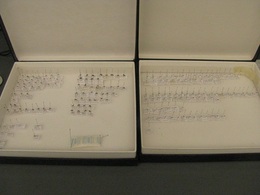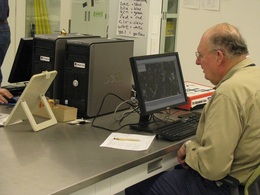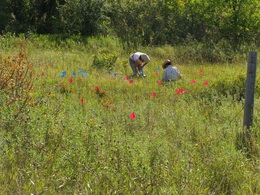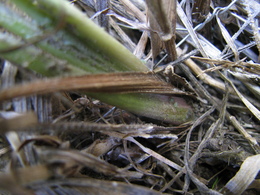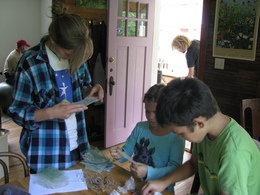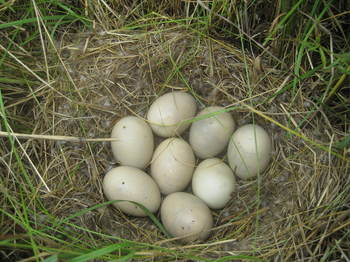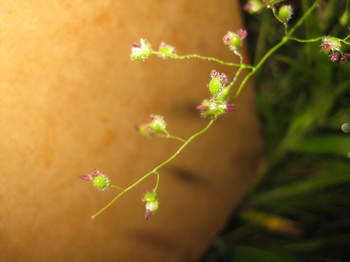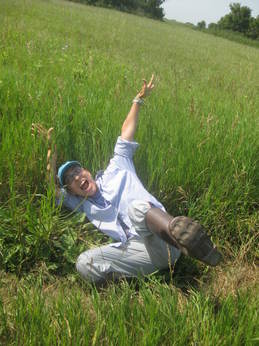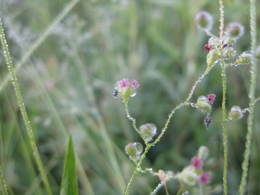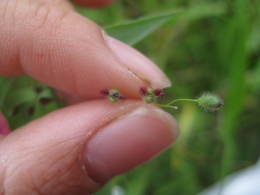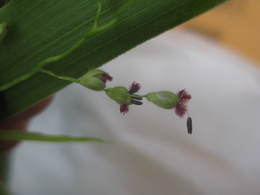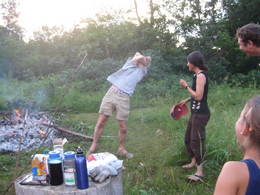|
|
We made a lot of progress this week. First, the volunteers finished the first round of counting for one of the larger experimental plots. There are still two more rounds of counting to finish, but we’re mostly there.
Suzanne started taking inventory of the heads we harvested this year. It didn’t take her long to get through everything, considering flowering was so low this year. Out of about 500 heads, there was only one that was mislabeled. There were a few missing, but they are on their way back from Minnesota.

I’ve been busy trying to identify all the ant specimens we have pinned. Right now it looks like we have two species of Lasius, five species of Formica, and one species each in several other genera. There are also multiple species within the genus Myrmica, but I haven’t identified them yet. Apparently that genus is particularly difficult to identify.
This summer, REU student Jill Gall put together a large collection of ants from prairie remnants in Minnesota. Yesterday, Stuart and I headed over to Lakeforest College to seek the advice of resident ant ecologist Sean Menke. Jill left us with two boxes of ants, which she pinned and identified to genus and separated into morphotypes:

Sean was impressed with her identification skills: she was correct in nearly every identification to genus and many of her morphotypes were consistent. He gave us some tips on what traits to look for when identifying ants. Now we have a plan for going through the rest of the collection. This will allow us to compare the species diversity of ants among prairie remnants, and hopefully pave the way for future ant research in the lab.

Now that the summer field season has come to an end, it is time to focus on what’s going on in the lab at the Chicago Botanic Gardens. I am taking over for Josh as lab manager and have spent most of the week learning my way around the lab.
Since I arrived, the two major tasks for the volunteers have been counting, randomizing, and weighing achenes from heads collected in 2011.
Here is Aldo, using the computer to count achenes from a scanned image:

Once we have a count of achenes for each head, we select a random sample for weighing. Here is Char, randomizing achenes based on a numbered grid:

As for the 2012 harvest, we brought a little over 500 heads from the main experimental plot. This is much less than the 2890 heads collected last year. Our haul from this year also includes heads from Kelly’s phenology study, heads from Shona’s hybridization experiment, and a sizable collection of ants from prairie remnants. We have plenty of work in store for the coming months.
Maria here.
Woke up this morning to some rumbling thunder in the distance.
The skies looked grey, but nothing too bad. We discussed how to do all the things we had to do at Staffanson: demo rechecks, harvesting Kelly’s Echinacea heads, removing twist-ties and flags from heads/plants that Kelly won’t harvest, figuring out 6 nearest neighboring Echinacea plants to each of Kelly’s plants that was going to be harvested, and pulling up ant traps. Whew!
We did some individual project stuff from 9 to 11am. Jill finished up sorting ants. Katherine and Kelly went to NWLF and NNWLF to pull ant traps and remove twist-ties from heads. I was in CG 99 South, measuring Dichanthelium from my maternal lines experiment, and got 4 rows done before 11am.
We set off for Staffanson, all 5 of us cozy in the truck. The corn and perennial weeds greeted us happily on the dirt road leading into Staffanson. Jill went to pull up her ant traps and then helped Kelly to remove twist-ties and flags. Stuart, Katherine and I brought out Sulu (the GPS), R2D2 (the netbook), and paper datasheets, and tried to figure out how to determine the 6 nearest neighbors to Kelly’s harvest heads. We concluded that the most efficient way was to use R to determine the 6 mapped nearest neighbors, obtain the distance to the 6th neighbor, then use a reel tape to measure out the distance and search to see if there are any other nearest neighbors closer than the mapped one. We would have to do it another day.
Here’s a fancy spider Stuart found on his knee today. Photo courtesy of Katherine.

On the way back for lunch, Stuart and Kelly belabored the pros and cons of color coding the top and bottom GPS poles.
After lunch we set out for Staffanson again. Kelly worked solo to harvest heads, while the four of us split into 2 teams (1 GPS + 1 clipboard) to do demo rechecks. After a little while, it started sprinkling and we heard some distant portentous thunder, so we turned back and left Staffanson.
Back at Hjelm House, Jill and Katherine cleaned up the ant traps and went to pull ant traps at Nessman. Stuart demonstrated dissecting achenes from Echinacea heads for Kelly, so she can dissect the heads she harvested when she’s at Carleton.
Lastly, as requested by Stuart, the “Sync Your Visor” song I came up with as an alternative to “Sync, Sync, Visor Sync”:
(To the tune of “Oh My Darling Clementine”)
Sync your visor, sync your visor,
Sync your visor everytime;
Data lost and gone forever
Don’t be sorry – sync it now!
Any suggestions for improvement are much welcome.
The past couple of days have been lovely for outdoor work–sunny, cool, a little breezy. On Monday we said bon voyage to the Wagenius family as they prepared for their trip back to Chicagoland. Stuart will be back next week, but Gretel and the kids are done for the summer. Now there are five of us and no shortage of work to do.
Monday morning we went to the site off of hwy 27 to take demography data on plants that flowered last year and reconcile errors from this year’s demography census. With two teams working with the GRS-1 GPS units, the task went quickly and smoothly.
We spent Monday afternoon re-finding seedlings at KJ’s. This is a particularly challenging site because there is a high density of plants in a small area. We continued the endeavor this morning, and I’m happy to say are nearly finished. We should be able to defeat the beast tomorrow morning.
Here are Jill and Maria looking for seedlings at KJ’s. Red flags mark completed focal plants.

This afternoon we performed some routine maintenance of the main experimental plot, pulling out flags that marked plant we could not find. Then we spent the rest of the afternoon on individual projects.
Karen Taira, who came up last week, has been spending her days working on her pollination experiment involving several species of Helianthus. Her field story of the day was that she found a pile of entrails next to one of her experimental plants. Apparently they were bigger than a prairie dog’s and smaller than a human’s. Perhaps it’s a new form of sacrificial sun worship–Praise Helianthus!
Like their hosts, Echinacea aphids exhibit a strong seasonality. There’s a sharp rise in the frequency and abundance of aphid infestation followed by a rapid decline in early fall. That decline has occurred much earlier this year than last year. Fortunately, that has given me a chance to make some observations about what happens to aphids at the end of the summer. Here are a few things I’ve noticed:
1. Throughout my surveys in CG1 and several prairie remnants, I’ve noticed that the frequency of winged morphs has declined since July. Last week, I did not see any winged aphids, with the exception of a couple at East Elk Lake Road. This implies that dispersal declines as aphid numbers drop.
2. I and several others have noticed that aphids are starting to congregate at the base of the plant both at the petioles and at the base of the stem. I’ve also seen aphids crawling down beneath the soil surface and a few latched onto the tops of roots. One possibility is that as plants withdraw resources from their leaves, aphids move down the plant to follow their food source. I’ve also seen ants moving aphids at the base of the plant and placing them in dirt structures. These observations support the notion that aphids overwinter on Echinacea roots.
Many aphid species in temperate regions spend the winter and summer on different plants. Their winter host is where they lay eggs and their summer host is where they feed and reproduce asexually. My guess is that Aphis echinaceae does not have a separate winter host.
This plant at Nessman’s had a bunch of aphids congregated at the base. Notice the little green guys on the stem:

This is one of the plants from my aphid addition/exclusion experiment in CG1. There are still aphids on the leaves, but most of them have moved to the petioles:

Tuesday was a cool, windy day with scattered rain showers. In the morning we descended on KJ’s, a small site chocked full of Echinacea, to check on seedlings in Amy’s recruitment study. We made some progress, but we have a long way to go at that site.
In the afternoon, we all crammed into the pickup truck and rode over to Krusmark’s, an isolated site near the Wagenius property. Maria was especially excited to ride in the truck bed. We collected demography data on flowering plants and gathered seed from sideoats gramma grass (Bouteloua curtipendula) to scatter in the main experimental plot.
Since there were not many flowering plants, we finished up in time to catch up on chores around the field station. Here’s the Wagenius kids helping Shona clean up after her pollination crossing experiment. She and several others developed a wire contraption to keep the pollinator exclusion bags away from the anthers.

It is bittersweet to see a good summer coming to a close. Lydia left on Sunday, Andrew’s leaving on Wednesday, and Shona will head out on Friday. Although we are sad to see them go, we have plenty of work to distract us from our sorrow.
Today was a cool day! High temp of mid 70s.
Ruth and Amy came up from the Twin Cities, to give us a jumpstart to Seedling Refinds.
We overcame some technical hurdles with DroppedBoxx on Sulu and Chekov (our two lovely GPS units), and started seedling refinds at Steven’s Approach in the morning, worked way past lunch hour before Stuart called timeout.
We had lunch supplemented generously with bounty from the Wagenius family garden – juicy chestnut crabapples, ripe sweet cantaloupe, and cool yellow watermelon!
After lunch we stopped by the road outside CG2/Jennifer’s Plot at Hegg Lake, and harvested Bouteloua. We will broadcast the Bouteloua seeds in CG2 after the burn if DNR decides to burn the plot; otherwise we will broadcast half the seeds in the fall and half in spring.
Then we resumed seedling refinds at Steven’s Approach. We solved some tricky mysteries with the seedling maps, and completed Steven’s Approach! We also found a couple of flowering plants that had been missed during demo.
While we were doing all that, Karen was working hard at her independent project. The searching and keying paid off as she found a third species of Helianthus, H. tuberosus, at Hegg Lake.
Here’s an unrelated picture of a pheasant’s nest near my Dichanthelium plot. The pheasant mum and I often startled each other during those mornings when I did fieldwork.

Look, a pheasant egg!

And I know you’ll forgive me for posting yet another picture of Dichanthelium 😀

Hi all, Maria at K-town.
It was raining this morning as we bade goodbye to Lydia. All the best to Lydia as she prepares to go to Ireland for study abroad! Here’s a great picture to remember the fun times in the prairie 😀

Karen arrived at the town hall yesterday evening! This morning, she braved the rain and went out to many prairie remnants to look for Helianthus. She reports that Riley, Staffanson and Hegg Lake seem to hold the best promise for her pollen limitation experiments with H. maximiliani and H. pauciflorus, and maybe another H. species, if she can find it.
Andrew arrived back from his weekend trip announcing that he had all the food that’s bad for you all in one day. He, Shona, and Jill went to watch Alladin, the play by the Prairie Fire Children’s Theatre that Per and Hattie were in. They enjoyed it very much!
The skies gradually cleared up though temps were still in 60s-70s. It was quite chilly in the town hall.
With the squash, zucchini, and cucumber explosion 😀 😀 :D, Shona made zucchini bread. We also welcomed Kelly’s return from Northbrook about an hour ago.
Lastly, here’s a beautiful photo of Dichanthelium with morning dew:

Howdy folks,
Maria reporting from K-town.
Sunday we had a real day off =)
The weather was good and sunny, but not too hot.
Random tidbits from the town hall:
Shona made oatmeal pancakes for breakfast – they were really yummy – thanks Shona!
Kelly and Shona went swimming at Elk Lake and bumped into the Wagenius family
Katherine found a new trail in the forest at the Runestone Park on her biking adventure
Andrew had a great time at home and arrived at the town hall before 11pm
Lydia spent the day helping out in the kitchen at the camp in Alexandria
I made Irish Soda Bread to use up some sour milk, but still have ~1 cup sour milk (turned into buttermilk substitute, any ideas what to do with it? Pancakes would be easiest, but we just had them)
After the weekend break, it’s time for work again! Monday (today) we divided and conquered.
AM – Greg set out his yellow pan traps in his remnants. Stuart, Katherine, Jill, Lydia and I did demo in the remnants. Ruth and Greg came to join us. We found many Echinacea flowering at Loeffler’s Corner East, an okay number at Loeffler’s Corner West, 2 at Railroad Crossing (Douglas County), and ~6 at Yellow Orchid Hill.
The others (Shona, Kelly, Andrew) did CG1 rechecks and then worked on their independent projects.
Ruth bought some delicious fluffy spongy chocolate cake which we cleaned off the dish.
PM – The two teams switched jobs. Stuart led Shona, Kelly, Andrew, Ruth and Greg in demo at KJs and On 27. The rest of us did CG1 rechecks, and then worked on independent projects.
Here’s a file called “Crash Course in R”, which might be helpful to folks
crashR.2.pdf
Now for some photos!
Flowering Dichanthelium!

I think this is a super cool picture as it shows 3 stages of Dichanthelium stigmas/anthers emergence. See how the bottom-most spikelet has the stigma just emerging, while the anthers are still inside; the middle spikelet is open and has both stigma and anthers well-exserted; and the top spikelet is closed and the anthers are drooping out from the spikelet.

Last but not least here’s an epic picture from our bonfire last year 😀

|
|


